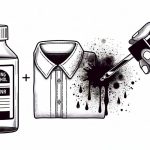Are you wondering if using isopropyl alcohol on your silk fabrics will cause damage? Look no further for answers.
This article dives into the chemical properties of isopropyl alcohol and its effects on silk fabrics. Discover tips for testing its compatibility with silk and alternative cleaning methods.
Learn about precautions to take and how to properly dilute isopropyl alcohol for safe use on silk fabrics.
Stay informed and keep your silk looking its best.
Table of Contents
Is Isopropyl Alcohol Safe to Use on Silk Fabrics
Isopropyl alcohol won’t damage your silk fabrics, so you can safely use it for cleaning. Silk fabric is delicate and requires special care to maintain its beauty and longevity. When it comes to cleaning silk, it’s crucial to choose the right method to avoid any damage.
Isopropyl alcohol is a safe and effective option for cleaning silk fabrics.
To clean silk using isopropyl alcohol, start by diluting it with water. Mix equal parts of isopropyl alcohol and water in a spray bottle. Gently spray the solution onto the stained area of the silk fabric. Then, take a clean cloth or sponge and dab the stained area, being careful not to rub it vigorously. Let the fabric air dry completely before wearing or storing it.
Isopropyl alcohol is effective in removing stains like ink, oil, and grease from silk fabrics. It evaporates quickly, leaving no residue behind. However, it’s essential to test the solution on a small, inconspicuous area of the fabric first to ensure it doesn’t cause any discoloration or damage.
Understanding the Chemical Properties of Isopropyl Alcohol
Isopropyl alcohol is commonly used as a cleaning agent, but when it comes to silk fabrics, it is important to understand its compatibility. While isopropyl alcohol can be used on silk, it is crucial to take precautions to prevent potential damage.
The chemical properties of isopropyl alcohol can cause silk to become discolored, weakened, or even dissolve in extreme cases.
Silk and Isopropyl Compatibility
Silk fabrics and isopropyl alcohol may not be compatible due to potential damage. While isopropyl alcohol is commonly used as a cleaning agent, it can have adverse effects on silk due to its chemical properties. Silk is a delicate fabric that requires special care and attention to maintain its luster and softness. When exposed to isopropyl alcohol, silk fabrics can experience discoloration, fading, and even structural damage. It is important to avoid using isopropyl alcohol directly on silk and instead opt for gentle cleaning methods specifically designed for silk fabric care. Here is a table outlining some alternative cleaning methods for silk fabrics:
| Cleaning Method | Description |
|---|---|
| Handwashing | Gently wash silk in lukewarm water and mild soap |
| Dry Cleaning | Seek professional dry cleaning services |
| Steam Cleaning | Use a handheld steamer to remove wrinkles |
Potential Silk Fabric Damage
To protect your delicate silk garments, it’s important to be aware of potential harm that can occur. Silk fabric care is crucial in maintaining the beauty and longevity of your silk items.
One common issue faced by silk fabric owners is dealing with stains. Common silk fabric stains include oil, sweat, makeup, and food. These stains can be quite stubborn and require special attention. It is crucial to treat these stains promptly to avoid permanent damage to the fabric.
To remove oil-based stains, gently blot the affected area with a clean cloth and apply a small amount of mild detergent. For sweat stains, soak the garment in cold water and then wash it with a gentle detergent. Makeup and food stains can be treated by spot cleaning with a mixture of mild detergent and water.
Remember to always follow the care instructions provided by the manufacturer to ensure the best results and to prevent any damage to your delicate silk fabrics.
The Effects of Isopropyl Alcohol on Silk Fabrics
When it comes to silk and alcohol compatibility, it’s important to understand the potential effects of using alcohol-based cleaning methods on silk fabrics.
While alcohol can be effective in removing stains from silk, it can also cause damage if not used properly.
Therefore, it’s crucial to explore safe silk cleaning methods that can help preserve the integrity of your silk garments while still achieving effective cleaning results.
Silk and Alcohol Compatibility
Isopropyl alcohol is a gentle yet effective option for removing stains from silk fabrics. It won’t harm silk fabrics, so you can safely use it to remove stains. Its low water content helps prevent shrinkage or color fading, which are common concerns when cleaning silk. To use isopropyl alcohol for silk fabric cleaning, simply dampen a clean cloth with the alcohol and gently blot the stained area. Be sure to test the alcohol on a small, inconspicuous area of the fabric first to ensure it doesn’t cause any adverse effects. By incorporating isopropyl alcohol into your silk fabric care routine, you can easily remove stains and keep your silk items looking their best.
Safe Silk Cleaning Methods?
Now that you know that isopropyl alcohol can potentially damage silk fabrics, it’s important to learn about safe silk cleaning methods. Taking care of your silk fabric and removing stains without causing any harm requires some special attention.
When it comes to silk fabric care, it’s best to avoid using harsh chemicals or solvents like isopropyl alcohol. Instead, opt for gentle cleaning methods. For minor stains, you can start by blotting the area with a clean, damp cloth. If the stain persists, try using a mild detergent specifically designed for delicate fabrics. Gently rub the detergent onto the stain, then rinse with cool water.
Remember to always follow the care instructions provided by the manufacturer to ensure the best results and longevity of your silk fabric.
Tips for Testing Isopropyl Alcohol on Silk Fabrics
It’s important to test isopropyl alcohol on a small, inconspicuous area of silk fabric before applying it to the entire garment. Testing methods can help determine if the alcohol will cause any damage or discoloration to the fabric. When testing, it’s best to follow certain best practices to ensure accurate results.
To begin, choose a small area of the silk fabric that is not easily visible, such as an inner seam or hem. Apply a small amount of isopropyl alcohol to a clean white cloth or cotton swab, and then gently dab it onto the test area. Avoid rubbing the alcohol into the fabric, as this can cause additional damage.
After applying the alcohol, carefully observe the test area for any changes in color, texture, or damage. If there are no adverse effects after a few minutes, it is likely safe to proceed with using isopropyl alcohol on the entire garment. However, if you notice any discoloration, damage, or changes to the fabric’s appearance, it is best to avoid using isopropyl alcohol and seek alternative cleaning methods.
Alternative Cleaning Methods for Silk Fabrics
To clean silk fabrics without using isopropyl alcohol, you can try alternative cleaning methods that are safe and effective. Isopropyl alcohol can potentially damage silk fabrics, so it’s important to explore other options for maintaining the beauty and longevity of your silk garments. Here are some natural silk cleaning solutions that you can use:
| Solution | Method |
|---|---|
| White vinegar | Mix one part white vinegar with three parts water. |
| Mild detergent | Dilute a small amount of mild detergent in water. |
| Lemon juice | Mix equal parts lemon juice and water. |
| Baking soda | Create a paste using baking soda and water. |
To clean your silk fabric using these alternative methods, follow these steps:
- Gently dab the stain or soiled area with the cleaning solution using a clean, white cloth.
- Avoid rubbing the fabric vigorously to prevent damage.
- Rinse the area with clean water to remove any residue.
- Pat the fabric dry with a clean towel or hang it to air dry.
Remember to always test the cleaning solution on a small, inconspicuous area of the fabric before treating the entire garment. By using these natural silk cleaning solutions, you can effectively clean your silk fabrics while keeping them safe from any potential damage caused by isopropyl alcohol.
Precautions to Take When Using Isopropyl Alcohol on Silk Fabrics
When using isopropyl alcohol on your silk garments, make sure to take precautions to prevent any potential harm or damage. Silk is a delicate fabric that requires gentle care, and using isopropyl alcohol can be risky. However, if you need to remove stains or odors from your silk garments, you can follow these precautions:
-
Test silk compatibility: Before applying isopropyl alcohol to your silk garment, it is essential to test it on a small, inconspicuous area. This will help you determine if the fabric can withstand the alcohol without any adverse effects.
-
Dilute the alcohol: To minimize the risk of damage, dilute the isopropyl alcohol with water. Mixing equal parts of alcohol and water will help reduce its strength and make it safer for use on silk.
-
Use a soft cloth: Instead of directly applying the alcohol to the silk, dampen a soft cloth with the diluted solution. Gently dab the affected area, being careful not to rub or scrub vigorously. This will help prevent any potential damage to the fabric.
How to Properly Dilute Isopropyl Alcohol for Silk Fabrics
By diluting the alcohol with water, you can safely clean silk garments without risking any potential harm. Silk fabric care requires proper cleaning techniques to maintain its delicate nature. Isopropyl alcohol can be a useful tool for removing stains from silk, but it must be used correctly to avoid damage.
To dilute the alcohol, mix equal parts of isopropyl alcohol and water in a spray bottle. Gently shake the bottle to combine the two liquids. Before applying the diluted solution to the silk fabric, test it on a small, inconspicuous area to ensure it does not cause any discoloration or damage.
Once you have confirmed the solution is safe to use, lightly mist the stained area with the diluted alcohol. Blot the stain with a clean, white cloth, working from the outside towards the center to prevent spreading. Avoid rubbing or scrubbing, as this can cause damage to the delicate fibers.
Once the stain is removed, gently blot the area with a clean cloth dampened with water to remove any residue. Allow the silk garment to air dry completely before storing or wearing it. Properly diluting the isopropyl alcohol will help you effectively clean your silk garments without causing any harm.
Recommendations for Cleaning Silk Fabrics Safely
Now that you know how to properly dilute isopropyl alcohol for silk fabrics, let’s dive into some recommendations for cleaning silk fabrics safely. Taking care of your silk garments is crucial to maintain their beauty and longevity. Here are three silk fabric cleaning techniques to keep in mind:
-
Handwashing: Start by filling a basin with lukewarm water and add a mild detergent specifically designed for delicate fabrics. Gently agitate the water to create suds. Submerge the silk garment and swirl it around for a few minutes. Rinse with cold water and gently squeeze out excess water without wringing. Lay the garment flat on a towel and roll it up to remove additional moisture.
-
Dry cleaning: If you’re unsure about handwashing, opt for professional dry cleaning. Look for a reputable dry cleaner experienced in handling silk fabrics. Make sure to inform them of any stains or specific care instructions for the garment.
-
Spot cleaning: In case of small stains or spills, you can spot clean silk fabrics. Use a clean cloth or sponge dampened with lukewarm water and a mild detergent. Gently blot the stained area, being careful not to rub or scrub aggressively.
Conclusion
In conclusion, when it comes to using isopropyl alcohol on silk fabrics, it is important to proceed with caution. While isopropyl alcohol can be effective in removing stains and odors from silk, it can also cause damage if not used properly.
It is recommended to test a small, inconspicuous area of the fabric before applying isopropyl alcohol to the entire garment. Additionally, diluting the alcohol with water can help minimize the risk of damage.
Ultimately, it is best to consider alternative cleaning methods or consult a professional for cleaning silk fabrics safely.
- 10 Types of Crepe Fabric You Need to Know (With Pictures) - June 23, 2025
- The Difference Between “Crepe” and “Crape” Fabric Explained - June 23, 2025
- Crepe Fabric Glossary: 20 Terms Every Sewist and Designer Should Know - June 23, 2025




